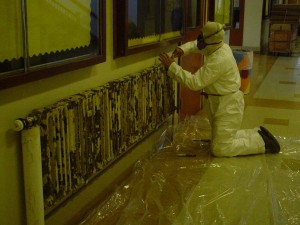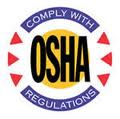Posted by admin under Admin Controls, Air Monitoring, Engineering Controls, Exposure, Federal OSHA, GHS, Hazard Communication, industrial hygienist, Management, MSDS, OSHA, PEL (Perm Exp Limit), Safety Policies, Training
Comments Off on When do you resample?
After performing an industrial hygiene survey (air monitoring), have you considered when you should resample? Here are some considerations that might help you in determining when.
- Are there specific rules that state when you must resample? For example, the construction lead standard (1926.62) states that you must resample yearly (or actually, that you can only use relevant results for one year).
- Has the process changedsince the last time you sampled? This one is hard to determine. Lot of things can change air monitoring results, here’s a “starter list” of things that can change a process.
- Different employee?
- Time of year? Summer versus winter? (closed up/open and humidity)
- Is a new tool in place?
- Has the ventilation changed?
- Have new controls been put in place? (administrative, systems operations)
- Has the product changed? Check the safety data sheet (aka MSDS).
- Are more (or less) employees exposed to this hazard? This might change some assumptions you have made about your risk.?
If you have air sampling performed, make sure you have a written report of your findings. Laboratory results without an explanation of how they sampled, where, # of employees, process description, PPE used, safety data sheets, etc….is worthless. You may remember is well enough, but OSHA will have a hard time believing that it is a similar exposure the next time you do the “exact same thing”.
Having this report and sharing it with the employees will fulfill (part of) the hazard communication standard requirement to employees.

Tags: air monitoring, air sampling, exposure monitoring, GHS, industrial hygiene, MSDS, OEL, OELs, OSHA, report, safety
On occasion, owners say they just want to do the minimum to be in compliance with OSHA. Most times this is due to lack of understanding.
 For some rules OSHA’s standard is right on the money. Take, for instance, lead (leaded paint) exposure. They have specific rules and guidelines that, if followed, keep virtually everyone protected*. The trouble is that some of OSHA’s rules have not been updated since 1973. New research and industry practices have found these levels to be unsafe even at current standards and exposure limits (PELs).
For some rules OSHA’s standard is right on the money. Take, for instance, lead (leaded paint) exposure. They have specific rules and guidelines that, if followed, keep virtually everyone protected*. The trouble is that some of OSHA’s rules have not been updated since 1973. New research and industry practices have found these levels to be unsafe even at current standards and exposure limits (PELs).
So, how do you know if the OSHA standards are current?
The quick answer is, you don’t.
Good safety professionals and industrial hygienists study the standards, recommended guidelines, and occupational limits worldwide.  In the US, the American Conference of Governmental Industrial Hygienists (ACGIH) provides the most current best practices. However, there are other methods and standards for specific hazards. ANSI, AIHA (although getting more dated due to lack of funding), European OELs (occupational exposure limits), and others.
It is rare that an employer knowingly exposes employees to a hazard. On the other hand, ignorance isn’t acceptable either….which might be the best reason for OSHA to be in existence. I wish they would spend more money on resources, information and training. Â Consult your safety professional!
*recently there is some discussion about low level lead exposure to children

